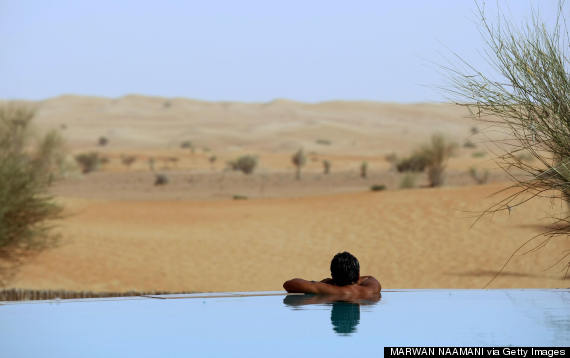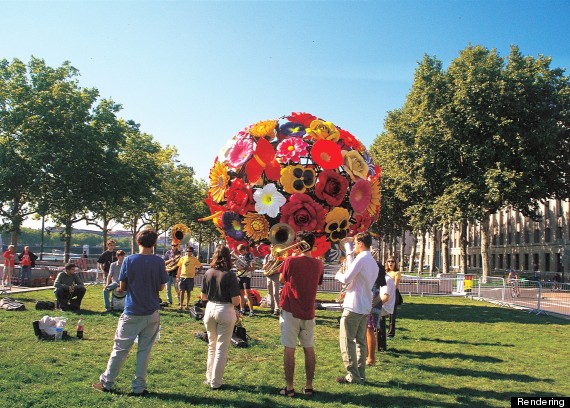Dominic Monaghan wants people to stop worrying about him.
He's certainly not in any danger of running out of interesting places to visit or animals to see for his OLN show "
Wild Things With Dominic Monaghan." Because even after two seasons, the actor-turned-nature-show-host's travel wish list is constantly growing. Monaghan doesn't have a death wish either, for anyone concerned he might get himself hurt -- or worse -- by wrangling the show's various dangerous critters or putting himself in the firing range of deadly spitting cobras (like Monaghan does in the "Wild Things" Season 2 premiere).
Still, while listening to fans' travel recommendations, Monaghan is continually having to reassure them that he's not "mental." He just wants to keep taking the show to more interesting, exciting places, while continuing to satisfy his lifelong curiosity with the natural world around him.
So, with Season 2 of "Wild Things" premiering on OLN on March 25, HuffPost TV Canada sat down with Monaghan to talk about all the amazing places and animals he's seen so far, getting to return to the Shire with a "Lord of the Rings" co-star this season, and what's still left on his seemingly never-ending bucket list.
HuffPost TV Canada: So I got to see the Season 2 premiere with the Kenyan giant spitting cobra. There were some pretty intense moments in there. I was cringing for you...
Dominic Monaghan: [Laughs] Oh, nice!
Who finds this show harder to watch when you're doing something potentially dangerous--- like encouraging a giant cobra to spit venom at your face -- your fellow producers or your family?
I think the producers are just happy that we're getting the footage. I think probably my family is the most nervous about it, but they know me well enough by now. They know I'm always going to do it, so it's not as scary as if it would be a new idea to them. It's not a new idea. I've been doing it for a long time.
What was your approach to this season? Were you looking to up the ante and take things further, or just continue exploring?
We definitely made the show bigger, bolder, brasher. The animals are more dangerous, the travel's more expansive. The whole season is just "Wild Things" with the accelerator pedal pushed down a little bit more. My thing for this year is about curiosity, about trying to entice a sense of curiosity out of people. I wanted people to be curious about life, about everything, about travel, about food, about people, about places, about animals. This season there's a big stance about being curious and about how curiosity can really dictate how you live your life.
Was there anything you wanted to do on Season 1 that you couldn't for whatever reason that you got to do this year?
Yeah, there were a few places that we went to and a few animals that we worked with that I really wanted to work with in Season 1 and we just didn't have the time, and we didn't really have the knowledge and we didn't have the experience, and people were a little reticent to get us into the firing lane like that. But I really wanted to go to Japan and we did that this year. I wanted to go to Thailand and we did that this year. I wanted to go to New Zealand, we did that this year. So we started to tick off a lot of things on the list. Once they knew that we could all do it, then they started saying, OK, well what do we want to do?
What was it like going back to New Zealand?
It was great. I'd been there two or three times since making the "Lord of the Rings" trilogy. But I went with Billy Boyd and he hadn't been back since we did "The Lord of the Rings" together. So that was kind of emotional for the two of us, and we just had a great time. I think we reverted back to who we were ... f**king 15 years ago. We were laughing and joking and behaving like hobbits again, so it was a great experience and quite emotional and a lot of fun.
Were there any places or animals that you remembered from filming "The Lord of the Rings" that you knew you had to go back and check out for the show?
I wanted to go to Waitomo. There's these caves in Waitomo that have these glowworms ... the whole ceiling glows like the night sky, and I wanted to take Billy there because he hadn't seen it the first time. And I had seen it and I loved it, and I wanted to show him that. And we wanted to go back to The Shire, which is obviously important for us, and we went to Wellington, where we were based out of and walked past Billy's house, walked past my house. Talked about that, had a glass of wine together. It was probably the most reflective of the episodes, but also probably the funniest, because Billy's in it and he's hilarious.
Being able to balance safely handling a dangerous animal while also talking to the camera at the same time isn't exactly a normal skill set. How long did it take for you to develop that, and are you even more comfortable with it now after having another season under your belt?
I think probably like halfway through Season 1, I thought I was in a headspace where I could handle most things and I could pick up on communications between me and a wild animal. You always have to take each individual animal on its own merits, you can't say, "Oh it's a cobra, so it's going to act like this." You have to say, "What is this cobra's attitude? How does it feel about humans, how does it feel about being held?" Most dangerous animals don't like being held, because they think they're in danger and then they're going to show you that they're dangerous.
So I think it took me half a season to get there, and you're always learning, you're always picking up on stuff and you're always subject to making mistakes. These type of shows really pop when someone gets hurt, when someone gets bitten, when someone gets close to being hurt. So we do walk that line a little bit, but safety is paramount for us, and for the animals on the show. And if we feel like we've pushed the limits, then we'll step away.
Is that disturbing to you at all that the more dangerous things get for you, the better it is for TV? It's kind of like how some people watch NASCAR for the crashes.
Well, I don't have a death wish. I'm not going to start falling out of airplanes without parachutes on. There's a level of sacrifice in terms of me working with animals that I'll do, but I'm not going to start grabbing lions by their tails and stuff like that, I'm not stupid. I'm OK with it, it's my passion. I'd much rather get hurt doing something I'm passionate about than get hit by a bus crossing the street going to McDonald's.
It seems like on a show like this you have to constantly keep your eyes open, not just for the safety aspect, but also in case you happen to spot something cool or unexpected. What's been the best happy accident that you've had on the show so far?
Well, we went to Japan to look for the Japanese giant salamander, which is as big as my calf. But what we also found is a hybrid, which is a Chinese giant salamander that mates with a Japanese giant salamander, and that thing was as big as a f**king Labrador. We didn't expect to see that at all, and we got a chance to work with it. So that was a standout moment in terms of like, "Whoa, we came to look for one thing and then there's this crazy other monster thing."
We saw a few different types of bats that we didn't expect to see in Australia, one that was relatively rare that we found in a cave. I don't know, for me, it's those moments where you go looking for something else and then you get wowed by other creatures. I didn't know that I was going to get a chance to work with a tuatara in New Zealand, which is a type of reptile that looks just like a lizard but it's not a lizard, and I got a chance to hold one and work with one. And that was kind of a dream moment for me; they're a very, very peculiar, strange animal. They can live til over 100, they live in very cold environments, they have a third eye. Very intelligent, smart little creatures.
Do you find now that the show's been around for a season that people are constantly coming up to you to suggest new ideas for places and animals for you to check out?
Yeah, yeah. [Laughs] You get that a lot. Friends or people on the street saying, "Oh, you've got to go do tigers in India," or you've got to go do this and that, and you're like, "Oh, yeah, that's great." What you don't want to say to them is we spend months researching these animals and these places, and if you've suggested it, I'm sure we've researched it and worked out that we can or can't do it. So yeah, people get excited, they want to contribute. On Twitter all the time, people are like, "You should come to my hometown, we have this and we have that," and "Come to this country and I'll take you out, and we'll go to these places." I love that enthusiasm, it's great.
What's it been like for you watching the public reaction to this show? Because you're kind of putting yourself out there a lot more than when you're playing a fictional character on a TV series or in a movie.
The main reaction on the street is like, "You're mental." Which obviously I try to explain why I'm not mental and why it doesn't feel mental to me. I don't want people to think that I'm crazy or that I'm doing something stupid. So I try to break those myths a little bit, but most people are just like, "You're crazy, don't die." And I'm like, "Well, thanks..." There's a line that I say in Season 1 of "Wild Things," which is true: I say, "I will avoid death at all costs," and I will. I'll do everything that I can to not die. I don't have a death wish, I'm not interested in dying. I'm just not scared of it, it doesn't scare me.
Have you always been like that? Or is that something that's developed as you've gotten older?
Not scared of death?
Well, not being intimidated by putting yourself in these types of situations.
I don't know. I wasn't the brave kid jumping off bridges and stuff like that when I was a kid, the daredevil or anything like that. I was more the class clown. But I was the guy that would take the bee or the wasp or the spider out of the classroom or help people out if there was an animal on them. I was always good like that, animals never bothered me. And I think as I became an adult, I just thought, you get one opportunity. I get one opportunity to be me. Maybe I'll come back and get an opportunity to be something else, but I only get one opportunity to be me. And I'm going to go do it.
So is there anything or anywhere still left on your list for a potential Season 3?
There's thousands of places. I want to go to Galapagos and tell the story of Darwin, how he got to a headspace where he started thinking about evolution and "Origin of Species." I want to go to Christmas Island, where they have tens of millions of crabs overtake a tiny little island in the middle of the ocean. I'd love to go the Cook Islands, I want to go to Antarctica, I want to go the South Pole. I want to go to Brazil again, I want to go to Argentina, Peru, Greece, Spain. We can tell thousands more stories in Australia; it's such an amazing place to go to for the animals that we work with. Cambodia. I'd love to go to places like Jordan and Lebanon and Israel. There's a lot of places, territories that we've not hit yet, and stories that we've not told. One of my producers said to me a while ago, "Do you ever think that you'll run out of ideas?" And I said, "No, because we'll never run out of animals." There's always going to be an animal's story to tell.
Season 2 of "Wild Things with Dominic Monaghan" premieres Tuesday, March 25 at 9 p.m. ET/PT, 7 p.m. MT, 8 p.m. CT on OLN in Canada, and on BBC America in the U.S.











